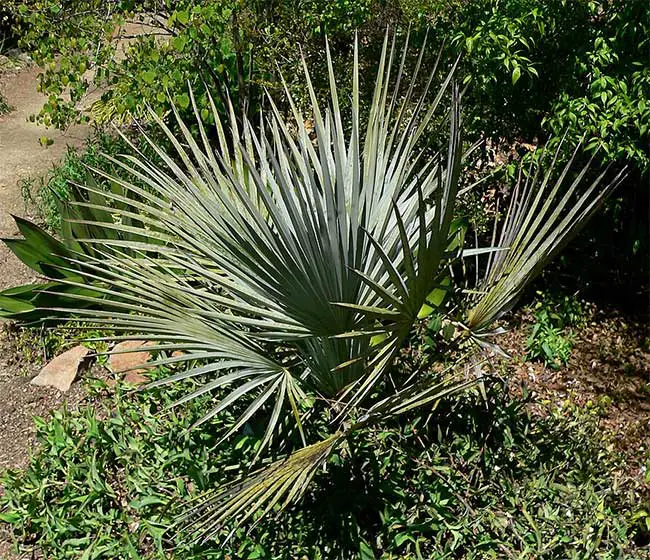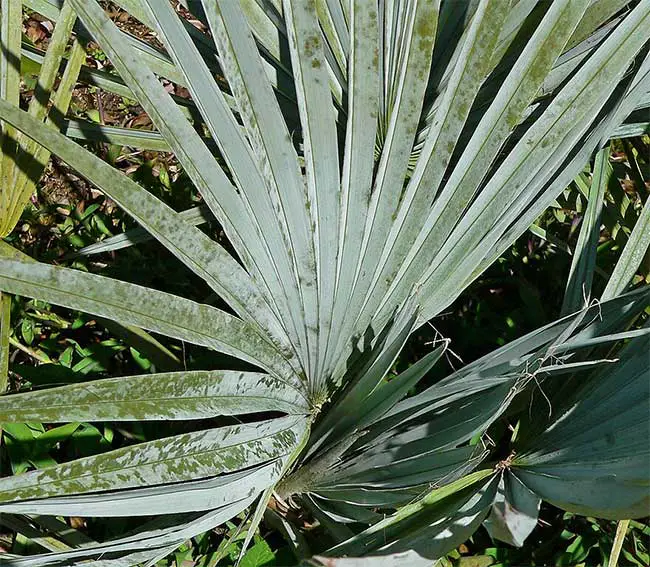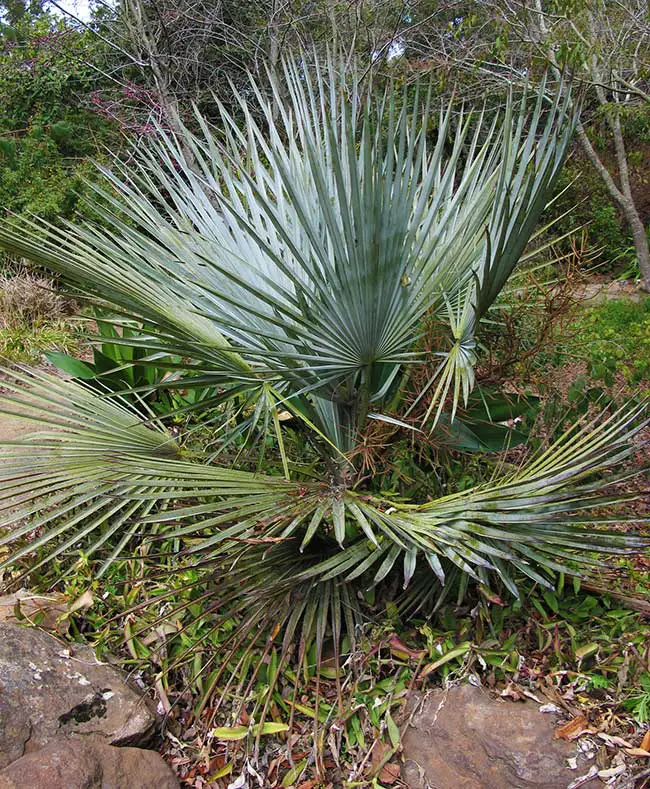
The Mexican Dwarf Blue Palm Tree, scientifically known as Brahea decumbens, is a captivating palm species native to Mexico. It is celebrated for its compact size, unique appearance, and adaptability to various landscapes.
Typically reaching heights of 3 to 6 feet (1 to 2 meters), this palm forms a cluster of slender trunks with a distinctive bluish-gray coloration. Its fan-shaped fronds display a striking blue-green or silvery-blue hue, adding a touch of elegance to gardens.
With its relatively slow growth rate and adaptability to different soil types and light conditions, Brahea decumbens is a sought-after choice for those seeking a visually appealing and manageable palm for landscaping.
Quick Facts:
| Scientific name: | Brahea decumbens |
| Common names: | Mexican Dwarf Blue Palm, Sierra Madre Palm, Sonoran Dwarf Palm, Blue Hesper Palm. |
| Origin: | Native to Mexico. |
| Growth Rate: | Slow. Up to 3-6 ft tall and 2-4 ft wide. |
| Cold Tolerance: | USDA Zones 8b (15 to 20 F) to 11 (above 40 F). |
| Light Req: | Full sun. |
| Water Req: | Moderate. |
| Soil Req: | Widely adaptable |
| Fruit: | Green to purple to black. Not edible. |
| Propagation: | Seeds. |
Mexican Dwarf Blue Palm Appearance
This palm typically remains small, reaching a height of about 3 to 6 feet (1 to 2 meters). Its compact size makes it suitable for both gardens and container planting.
It forms a clump of slender trunks, which have a notable bluish-gray coloration. The trunks often lean slightly and may be covered with the remnants of old fronds, creating a textured and rustic look.
The fronds of Brahea decumbens are fan-shaped and have a striking blue-green or silvery-blue color. These fronds are relatively small compared to some other palm species, typically measuring 2 to 3 feet (0.6 to 0.9 meters) in length.
Flowers and Fruits of the Mexican Dwarf Blue Palm
The Mexican Dwarf Blue Palm produces small and relatively inconspicuous flowers. These flowers are typically creamy or yellowish in color and grow in clusters, although they are not particularly showy or fragrant.
Despite their modest appearance, these flowers serve a vital role in the palm’s reproductive process by attracting pollinators, such as insects.
In terms of fruit, the Mexican Dwarf Blue Palm generates small and spherical fruits that start off green and gradually ripen to a dark purple or black color when they are mature. Each fruit is usually less than 1 inch (2.5 centimeters) in diameter.
While these fruits are not commonly consumed by humans, they are an essential food source for various wildlife species in the palm’s native habitat.
How to Care for the Mexican Dwarf Blue Palm
1. Sunlight: The Mexican Dwarf Blue Palm thrives in full sun. It requires at least 6 hours of direct sunlight daily to maintain its vibrant blue color and healthy growth. Planting it in a sunny spot will encourage its best development.
2. Soil: Well-draining soil is essential for the health of this palm. Sandy or loamy soils are preferable to prevent waterlogging, which can lead to root rot. Amending the soil with organic matter can enhance its drainage properties.
3. Watering: While this palm is relatively drought-tolerant once established, it still needs regular watering during its initial stages of growth. Provide consistent moisture to the root zone, allowing the soil to dry out slightly between waterings. Overwatering should be avoided to prevent root issues.
4. Fertilization: Feeding the Mexican Dwarf Blue Palm with a balanced palm fertilizer during the growing season (spring and summer) can promote lush foliage and healthier growth. Avoid excessive fertilization, as it can lead to nutrient imbalances.
5. Pruning: Minimal pruning is required for this palm. Remove dead or damaged fronds to maintain its neat appearance and to prevent pests and diseases from taking hold. Be cautious not to over-prune, as this can stress the palm.
6. Pests and Diseases: Keep an eye out for common palm pests like scale insects and spider mites. Regularly inspect the leaves and treat infestations promptly. Additionally, well-drained soil and proper watering practices can help prevent root rot, a common issue in palms.
7. Cold Protection: The Mexican Dwarf Blue Palm is known for its relatively good cold hardiness compared to many other palm species. It is typically rated as cold-hardy to USDA Hardiness Zone 8b, which means it can tolerate temperatures as low as 15 to 20 degrees Fahrenheit (-9 to -6 degrees Celsius) for short periods.
However, it’s important to note that the cold hardiness of this palm can vary depending on various factors, including the specific microclimate in your location, the age and health of the palm, and the duration of cold temperatures.
In areas where temperatures regularly drop below its tolerance range, providing protection during cold snaps, such as wrapping the palm with frost cloth or using heat lamps, can help prevent damage to the foliage and trunk.
Mexican Dwarf Blue Palm Pictures



I was wondering if you know of this type of palm:
Brahea decumbens, Sierra Madre palm
If so, can you tell me near Sarasota I might buy one?
Thank you.
Dennis
I’m a resident who enjoyed your article on the Mexican dwarf blue palm. Do you happen to know where this tree might be obtained? My searches are producing nil.
Thank you.
Dennis Ricke